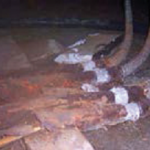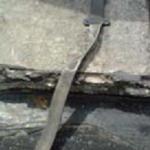|
Defects
|
Probable causes for the defect
|
Design for Maintainability (DfM) Guidelines
|
|
Corroded parts
 Corroded conductor
Dissimilar metal causes galvanic corrosion
|
- Dissimilar metals are connected without special precaution results in galvanic corrosion.
- Protective coating is damaged. Should be checked regularly.
|
Design
- Adhere to protection measures to reduce risk of damage by lightning (e.g. injury to living beings, physical damage and failure of electrical and electronic systems) as per SS 555-1:2010, BS EN 62305-1:2011, NFPA 780.
- Provide external lightning protection system (LPS) to intercept direct lightning flashes to the structure.
- Conform to design considerations for system earthing, including selection of type of earthing system to be used.
- Material selection and minimum dimensions (for earthelectrodes to resist corrosion) must comply with SS 551:2009 (see also BS 7430:2011+ A1:2015).
- Provide lightning electromagnetic impulse protection measures (LEMP) as per SS 555- 4:2010. (See also IEC 62305-4:2010).
Construction
- Construct and install air-termination system and LPS as per IEC 62305-3:2010, SS 555-3:2010.
- Installation to be performed by certified LPS installers.
- Choose electrode locations that avoid the drainage of fertiliser and other materials into the area.
- Top soil should not be mixed with the backfill around an electrode.
- To avoid hazards to adjacent ground systems, the electrode system should either be of compatible metals or
protected by adopting cathodic protection (BS 7430:2011+A1:2015, SS 551:2009).
Maintenance
- Perform a thorough check on surge arrestors and the earthing system once a year, together with the annual
shutdown.
- Monthly inspection must be conducted by a Licensed Electrical Worker (LEW). Such inspection should cover
internal LPS to avoid occurrence of dangerous sparking within the structure caused by lightning current flowing in the external LPS or other conductive parts of structure (IEC 62305-3:2010, SS 555-3:2010).
|
|
No /poor conductivity
 Unsecured clamp/joint
Exposed grounding rod
|
- Earth electrodes / conductors are not resistant to weathering or deteriorate over a long period of time.
- Inadequate contact with surrounding soil or incomplete network formed for all conductors in the building.
- Surrounding soil has poor conductivity and not treated for the same.
- Conductors if laid at inadequate depth or driven improperly get damaged.
- Fasteners are not corrosion resistant. Become rusted and loose contact over time. Should be checked regularly.
- Vandalism if cover of earth pit / inspecting chamber is not secured.
- Thorough tests not conducted after installation and at specified interval to detect such faults.
- Damaged electrode
- Inadequate burial depth or careless excavation in vicinity.
- Vandalism if cover of earth pit / inspecting chamber not secured.
|
References
[1]
Normative References/Standards Referred to for Air Handling Unit and Fan Coil Unit

